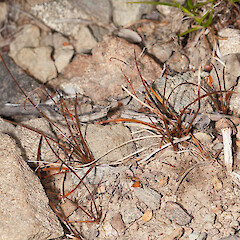Carex uncifolia
Common name
sedge
Synonyms
Carex cardrona Hamlin
Family
Cyperaceae
Flora category
Vascular – Native
Endemic taxon
Yes
Endemic genus
No
Endemic family
No
Structural class
Sedges
NVS code
The National Vegetation Survey (NVS) Databank is a physical archive and electronic databank containing records of over 94,000 vegetation survey plots - including data from over 19,000 permanent plots. NVS maintains a standard set of species code abbreviations that correspond to standard scientific plant names from the Ngä Tipu o Aotearoa - New Zealand Plants database.
CARUNC
Chromosome number
2n = c.60
Current conservation status
The conservation status of all known New Zealand vascular plant taxa at the rank of species and below were reassessed in 2017 using the New Zealand Threat Classification System (NZTCS) – more information about this can be found on the NZTCS website. This report includes a statistical summary and brief notes on changes since 2012 and replaces all previous NZTCS lists for vascular plants.
Please note, threat classifications are often suggested by authors when publications fall between NZTCS assessment periods – an interim threat classification status has not been assessed by the NZTCS panel.
- Conservation status of New Zealand indigenous vascular plants, 2017 . 2018. Peter J. de Lange, Jeremy R. Rolfe, John W. Barkla, Shannel P. Courtney, Paul D. Champion, Leon R. Perrie, Sarah M. Beadel, Kerry A. Ford, Ilse Breitwieser, Ines Schönberger, Rowan Hindmarsh-Walls, Peter B. Heenan and Kate Ladley. Department of Conservation. Source: NZTCS and licensed by DOC for reuse under the Creative Commons Attribution 4.0 International licence.
2017 | Threatened – Nationally Vulnerable | Qualifiers: RR, St, Sp
Previous conservation statuses
2012 | Threatened – Nationally Endangered | Qualifiers: RR, Sp, St
2009 | Threatened – Nationally Endangered | Qualifiers: RR, St, Sp
2004 | Range Restricted
Distribution
Endemic. North and South Islands. In the North Island known only from the Central Volcanic Plateau from Mt Hauhangatahi and in the nearby Moawhango. In the South Island much more widespread known from the Red Hills, between the Wairau Valley and Nelson, south through Canterbury to Central Otago.
Habitat
A species of damp seepages, open wetlands and damp turf within tussock grassland. Also abundant in damp sites overlying ultramafic rocks.
Detailed description
Shortly rhizomatous, dark purple red to beetroot red, densely tufted sedge 30–70 mm tall. Culms completely obscured by light grey-brown, chartaceous, somewhat fibrillose leaf-sheaths. Leaves 0.5 mm wide, dark purple-red, maroon red to beetroot red, much > culms, plano-convex, nerved on the undersides, smooth on the upper surface, margins scabrid, apex subobtuse, often curled. Inflorescence composed of short densely compacted spikelets, these 3–4–(5), terminal spike male, rather slender, shortly pedunculate, glumes lanceolate, acute, red-brown; remaining spikes female, these sessile, 5–12-flowered, glumes 3.5 × 1.5 mm, dull red-brown, distinctly nerved, lanceolate, acute with the mid rib extending into a scabrid awn. Utricles 2–3.5 × 1.5 mm, biconvex to obscurely trigonous, elliptic-lanceolate, spreading when mature, light red-brown, distinctly nerved, narrowed to a more or less scabrid beak 0.5–1 mm long, bidentate, orifice scabrid. Stigmas 3. Nut 1.5 mm long, dark grey-brown, obtusely trigonous, oblong-obovoid.
Similar taxa
A well marked species distinguished from the closely allied C. libera (Kük.) Hamlin and C. filamentosa Petrie by the spikes which lie almost buried within the leaves, sessile female spikes and shortly rhizomatous habit. It could be confused with C. hectorii Petrie but that species has much wider, green or reddish-green leaves, and smooth, dark brown mature utricles.
Flowering
September–January
Fruiting
October–May
Life cycle
Nuts surrounded by inflated utricles are dispersed by granivory and wind (Thorsen et al., 2009).
Propagation technique
Easily grown from division of whole plants and fresh seed. Best kept in a pot because it is intolerant of competition and slow growing. Deos best in a free draining, moist soil, enriched with magnesium. A very attractive and unusual sedge ideal for tub and pot cultivation on patios and verandahs
Threats
Naturally uncommon, this species has a biologically sparse distribution, reaching its greatest abundance on ultramafites on the Red Hills, West Dome and the Livingston Range. Elsewhere it is uncommon and some populations have been lost due to weed invasion, trampling from horses and through vehicle damage.
Etymology
carex: Latin name for a species of sedge, now applied to the whole group.
Attribution
Fact Sheet prepared by P.J. de Lange (10 August 2006). Description adapted from Moore and Edgar (1970)
References and further reading
Moore LB, Edgar E. 1970. Flora of New Zealand, Volume II. Indigenous Tracheophyta: Monocotyledones except Gramineae. Government Printer, Wellington, NZ. 354 p.
Thorsen MJ, Dickinson KJM, Seddon PJ. 2009. Seed dispersal systems in the New Zealand flora. Perspectives in Plant Ecology, Evolution and Systematics 11: 285–309. https://doi.org/10.1016/j.ppees.2009.06.001.
NZPCN Fact Sheet citation
Please cite as: de Lange, P.J. (Year at time of access): Carex uncifolia Fact Sheet (content continuously updated). New Zealand Plant Conservation Network. https://www.nzpcn.org.nz/flora/species/carex-uncifolia/ (Date website was queried)







